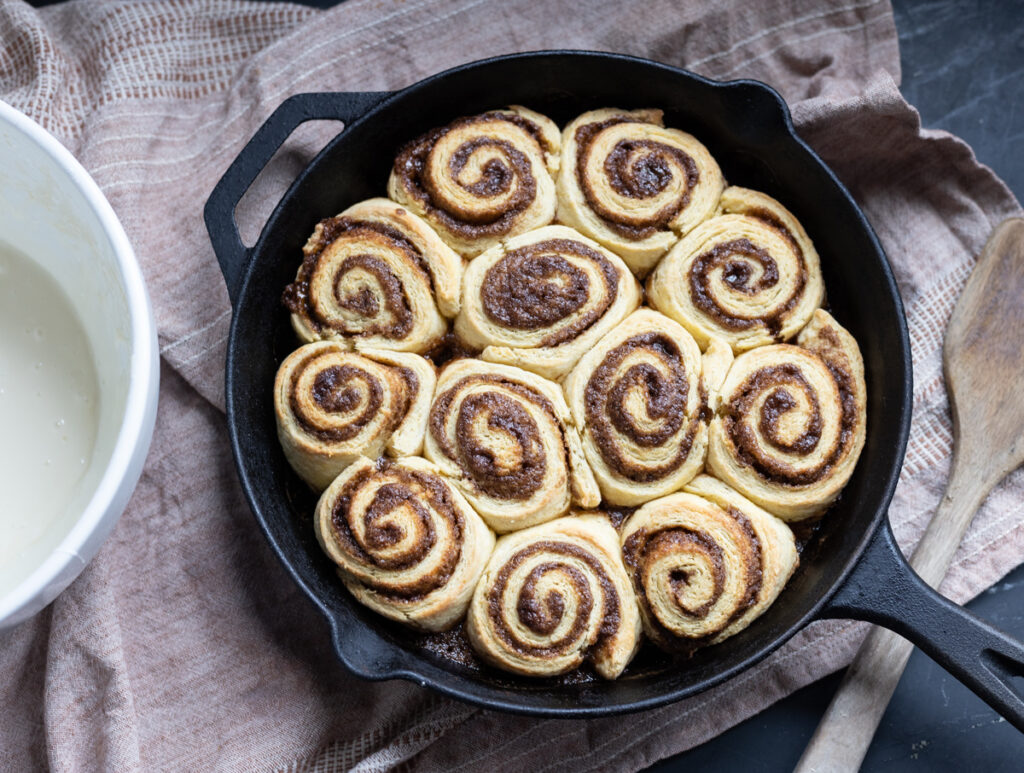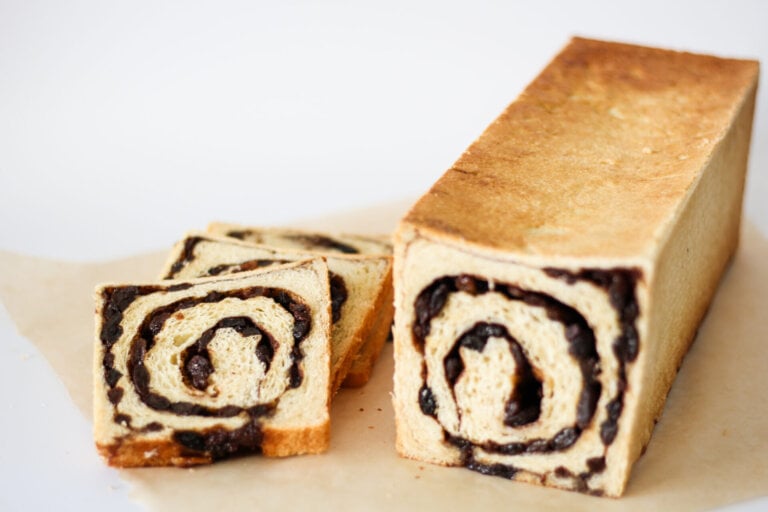How to Season A Cast Iron Skillet So It Lasts Forever
A well-seasoned cast-iron skillet is an absolute kitchen essential for home cooking! Learn to season a new cast-iron pan, maintain a good season, and cook properly with well-seasoned cast iron!
I may be compensated for some affiliate links in this post at no extra cost to you.
Cast iron is timeless, durable, affordable, non-toxic, and can be so simple to cook with when seasoned properly because it’s non-stick! One of the questions I get most when I’m showing something I’m cooking in cast iron and how it doesn’t stick is: How do you season your cast iron to get to that point?! So alas, I will share my seasoning technique. It’s an all-day endeavor, but there’s very little hands-on work or attention to be paid because the oven does most of the work.
I’m aware there are many people out there saying to do it this way or that and I’m not declaring myself the ultimate authority on cast iron cooking. I’m simply sharing what I have found to work the best for me in my kitchen after cooking with cast iron for 10+ years.

What is a well-seasoned skillet?
Seasoning is the process of creating a thin layer of protective coating on a clean cast iron pan to create a non-stock surface, prevent rust, and enhance the flavor of food cooked in cast iron. This seasoning (protective layer) is formed by applying a thin layer of oil or fat to a clean, dry cast iron piece and then heating it for an extended time at a very high heat.
Regularly seasoning cast iron to maintain the protective layer is recommended. However, this doesn’t necessarily mean you have to set aside time to re-season your cast iron. Simply using it to cook frequently with some kind of fat or oil will maintain the seasoning. Remember – seasoning cast iron is essentially just applying oil to the pan and heating it. So if you make scrambled eggs in your seasoned pan, for example, you will add some fat, heat it, and then cook the eggs. This process of adding fat and heating it before cooking the eggs “re-seasons” the cast iron – so properly maintained cast iron is very easy to keep after the initial seasoning process.

What is the best oil for seasoning cast iron?
Cast iron must be seasoned with oil or fat.
The most important thing is to choose an oil or fat with a high smoke point, which just means that the oil can withstand a very high temperature without smoking or breaking down. Common oils and fats used for seasoning cast iron are:
- Vegetable oil: smoking point 400-450°F (204-232°C).
- Flaxseed oil: Has a low smoke point of around 225°F (107°C) but has excellent polymerization properties so it works well for seasoning cast iron, but needs several applications at low heat.
- Canola oil: smoke point 400-450°F (204-232°C).
- Grapeseed oil: smoke point 420-450°F (215-232°C).
- Sunflower oil: smoke point 440-450°F (227-232°C).
- Lard: smoke point 370-400°F (188-204°C).
- Coconut oil: Refined coconut oil has a smoke point of around 400-450°F (204-232°C), while unrefined coconut oil has a lower smoke point of around 350°F (177°C).
- Olive oil: Extra virgin olive oil has a lower smoke point, typically around 375°F (191°C). Refined or light olive oil has a higher smoke point of around 410-430°F (210-220°C).
Traditionally, lard was used to season cast iron and is still a favorite for those wanting a natural option. However, it’s only advisable to season with lard if you’ll be using your cast iron regularly because it can go rancid. Coconut oil and olive oil are also popular natural alternatives. I personally do not use seed oils in our home so I prefer one of these three natural options.

What You’ll Need
- Cast Iron Pans
- High smoke point oil for seasoning (flaxseed oil, vegetable oil, cooking oil, olive oil and coconut oil all work fine – lard can be used as well if you use your cast iron often)
- A baking sheet or piece of aluminum foil to protect the bottom of the oven from oil drippings
- Chainmail scrubber or steel wool (if you’ll be rehabbing old cast iron)
New Cast Iron Pan Seasoning Process
- Preheat the oven to 450F and place a piece of aluminum foil or a baking sheet on the bottom rack or bottom of the oven.
- Wash the new pan with hot water, then place it on the stovetop and heat it until it is dry.
- Lightly coat the surface of the pan with a small amount (1t – 1T) of oil or fat of choice. You don’t want too much oil, so wipe any excess oil away with a paper towel. The entire pan should be lightly coated with oil or fat, but not dripping.
- Place the pan in the preheated oven upside down for one hour.
- Remove the pan after an hour, and let the pan cool for at least 15 minutes.
- Then repeat steps 3-5 at least four times that same day. This process will take 5-6 hours total, but as you can see very little of that is hands-on time.

How often should you season cast iron?
With this method, you shouldn’t need to re-season your cast iron at all if you use your cast iron properly, because you sort of “re-season” it with each use. But if you scorch something and have residue stuck to the bottom, you may need to use a chainmail scrubber (you can also use steel wool) to clean the pan and then it would be a good idea to re-season it using the steps above.
Now that you’ve seasoned your cast iron cookware, you’ll need to maintain and use it properly. But first, a note on foods that don’t mix well with cast iron – even if you’re using a well-seasoned cast iron pan:
Foods to Avoid with Cast Iron
- Highly acidic foods: Prolonged cooking or storage of highly acidic foods like tomatoes, citrus, vinegar-based dishes, or marinades can break down the seasoning on cast iron and alter the taste of the dish.
- Delicate foods: Some delicate foods like cheese sauces or fish may have a sort of iron taste when cooked in cast iron.
- Sticky or starchy foods: Sticky foods like caramel or cheese sauce might be challenging to release from a cast iron pan due to its naturally porous surface. Starchy foods like mashed potatoes or risotto can also stick and make it difficult to clean the cast iron properly.
- Raw or acidic dairy products: Cooking raw milk or acidic dairy products, such as yogurt or sour cream, directly in a cast iron pan may cause the dairy to curdle or react with the iron, which can change the taste and texture.
How to Cook with Well-Seasoned Cast Iron

- Preheat cast iron on low-medium heat until it’s hot, but not smoking.
- Add a bit of oil or fat to coat the surface
- Once oil/fat is melted and distributed evenly over the cooking surface, you’re ready to go!
- Stir frequently when cooking at high temps to avoid scorching food.
How to Clean Seasoned Cast Iron
When used properly, cast iron should stay in good shape and rarely need to be washed since it is non-stick. To clean it, you can simply wipe any remaining food out of the pan, heat it briefly to make sure it is dry, and then coat it with a bit of oil or fat so it doesn’t rust.
One of my favorite tricks for washing cast iron that isn’t able to be wiped clean is just filling it with some warm water, heating it on the stove until the water is boiling, and then emptying the water and wiping it clean. The boiling water trick removes almost any stuck-on leftovers from cast iron and is the easiest way to clean up a stubborn mess. After wiping clean, return the empty, clean cast iron pan to the stovetop and heat it to dry it, then coat it with a bit of oil or fat to prevent rusting, and its good to go for next time.
If the boiling water trick doesn’t work, you can clean your cast iron pan with a soft bristled scrub brush and some warm, soapy water. Yes, I know the old saying goes that you can’t clean cast iron with soap. BUT, if it is well seasoned, the seasoning prevents the cast iron from absorbing the soap and it’s just fine. I occasionally burn something and need to scrub a cast iron piece with some soapy water before drying and oiling it down again and I have never once noticed a soapy taste or wearing down of my seasoning from occasionally washing in this manner.
If you really scorch something, you may need to use a chainmail scrubber or steel wool to clean the pan. After that, it doesn’t hurt to re-season using the seasoning method above at least once or twice using the original process.

My Favorite Cast Iron Cookware
Shop all of my favorite cast iron pieces here on my Amazon Storefront
Set of 4 skillets: 6?, 8?, 10?, and 12?. These are everyday skillets that you can use for all of your cast iron needs. Cast iron is an affordable homestead kitchen staple, these sit on my kitchen counter all the time and are used almost every day. They’re a fraction of the cost of some of the big-name non-stick brands, and mine are truly non-stick and non-toxic since they are seasoned!
Lodge Grill & Griddle: I use this griddle almost daily for making toast, sourdough pancakes, etc. It is not connected to my stovetop, but it lives here permanently unless it’s flipped so I can use the grill side.

Deep dish pizza pan: I use this for not only pizza, but making large amounts of food at one time or making big skillet dinners.

Bread Pans: I bake all kinds of bread in these, sourdough loaves, sweet breads, etc.








For the reason that the admin of this site is working, no uncertainty very quickly it will be renowned, due to its quality contents.
Please write more about the challenges you mentioned — curious for solutions.
Pretty! This has been a really wonderful post. Many thanks for providing these details.
This is a great way to manage stress. A regular massage can be a game-changer.
“Businesses get free GDPR tools—auto-anonymize EU user data effortlessly.”
I like the efforts you have put in this, regards for all the great content.
I’m often to blogging and i really appreciate your content. The article has actually peaks my interest. I’m going to bookmark your web site and maintain checking for brand spanking new information.
I really like reading through a post that can make men and women think. Also, thank you for allowing me to comment!
I just like the helpful information you provide in your articles
I just like the helpful information you provide in your articles
16 GB KVM VPS $9.99/mo 8 vCPU Cores 240 GB Fast NVMe SSD Storage 16 GB Ram 4 TB Bandwidth Choice of Operating System US East Coast Data Center Full Root Access 1 Dedicated IPv4 Address Webmin Server Panel – Optional
I am truly thankful to the owner of this web site who has shared this fantastic piece of writing at at this place.
Hasar süreçlerinde de çok yard?mc? oldular, adissigorta.com’u tavsiye ederim.
I very delighted to find this internet site on bing, just what I was searching for as well saved to fav